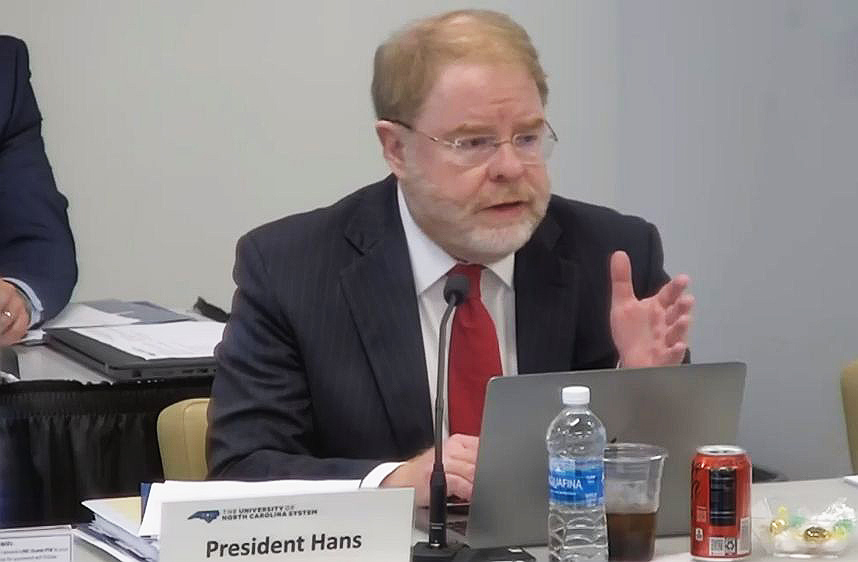UNC System President Peter Hans at a Board of Governors meeting earlier this year. (Screengrab PBS NC/UNC Board of Governors)
Campus repairs and other costs associated with recovery from Hurricane Helene for the UNC System will total about $32 million, university officials said Thursday.
Helene, which devastated western North Carolina in late September, forced closures and knocked out critical infrastructure at UNC-Asheville, Appalachian State University and Western Carolina University, among other campuses.
Repairs to structural damage on UNC System campuses are estimated to cost about $18 million, chief financial officer Jennifer Haygood told the University of North Carolina Board of Governors. Multiple campuses saw buildings flood, and a 4-H youth camp and PBS NC also sustained infrastructure damage.
Additional costs from debris removal, cleanup, minor repairs and mutual aid will total another $14 million.
Haygood said all things considered, the university was left in a “very fortunate position.”
“While those are not anything to blink at, I do think our system fared very well,” she said.
The system is estimated to lost about $19 million in revenue as a result of the storm. But that number doesn’t include potential enrollment drops for the coming spring semester.
UNC System President Peter Hans said the system will be seeking insurance reimbursement for whatever physical repairs can be covered. But the damage estimates are also likely to inform how the system requests further aid from the state.
The North Carolina General Assembly passed a first round of aid earlier this month, primarily aimed at qualifying for federal disaster aid. Lawmakers are set to return to session next week to allocate more relief.
In 2018, after Hurricane Florence hit the eastern part of the state, lawmakers laid out $30 million for UNC System repair and recovery efforts as part of their second round of aid.
22,000 vacant jobs across university will be eliminated in coming months
UNC System campuses will begin eliminating jobs that have been vacant for more than a year over the coming months.
That means more than 22,000 vacant positions will be eliminated, Hans told the Board of Governors, as part of a larger overhaul to the system’s human resources infrastructure. The system currently employs a total of 49,300 permanent employees — a number that includes 14,600 faculty members.
The vacancies create “bad budgeting practices” and “prevents everyone from understanding staffing” across the system, Hans said.
Those year-long open roles account for the vast majority of vacancies across the system, with 30,000 total. They will be eliminated by “early 2025” unless “they have a very good reason,” Hans said, like an ongoing search.
Roughly 20% of those vacant positions are currently funded by the state. That means the money currently “can be used with greater discretion,” which is “not necessarily a bad thing,” said Board of Governors member Art Pope, a state budget director under former Gov. Pat McCrory. “But for accountability, it’s better to have that budgeted consciously.”
Hans said that in the past, there were “regulatory incentives” that spurred campuses to “horde vacancies.” But as university officials aim to make HR more efficient under a 2023 law, he said, “it’s past time we cleaned up those vacant positions.”

